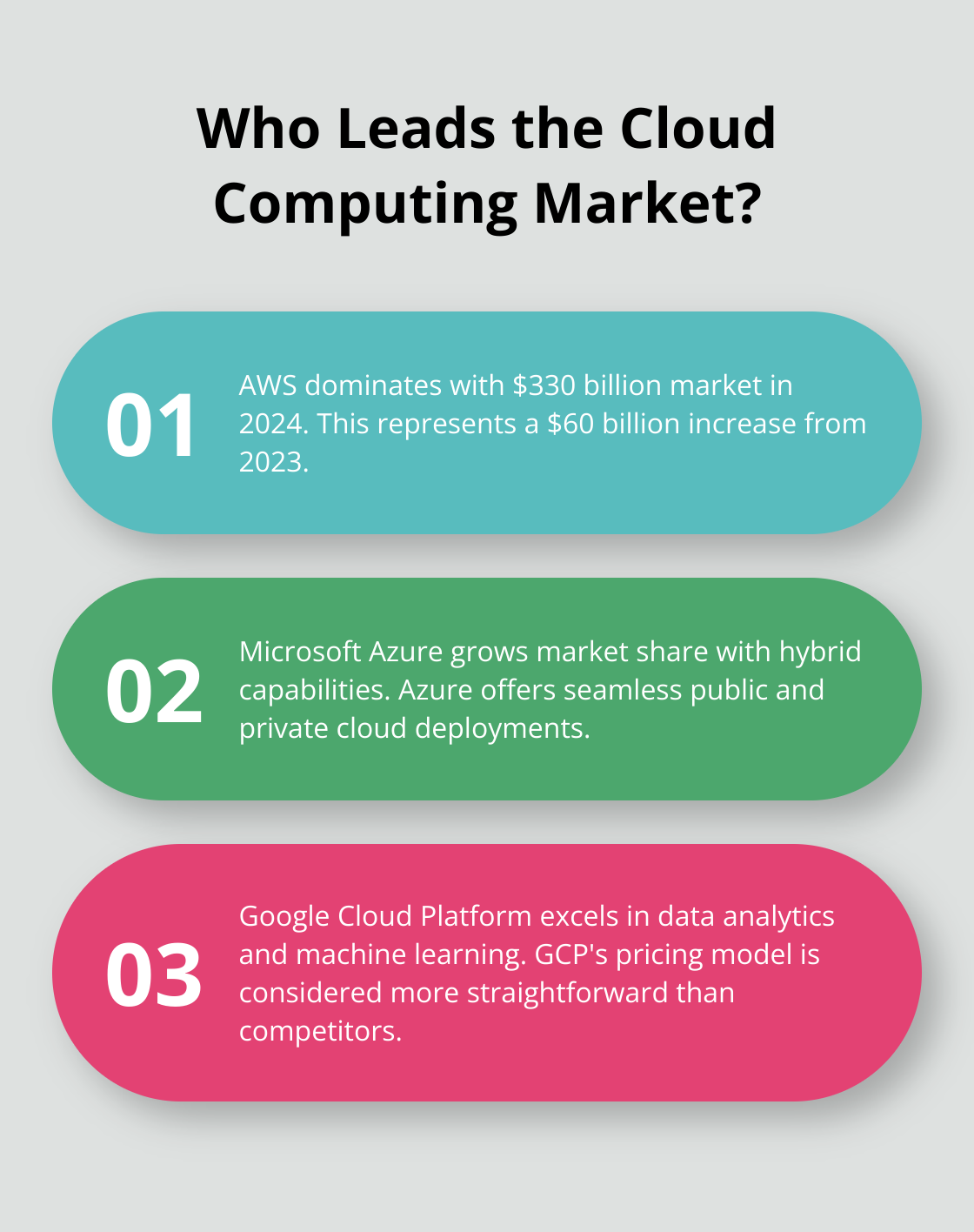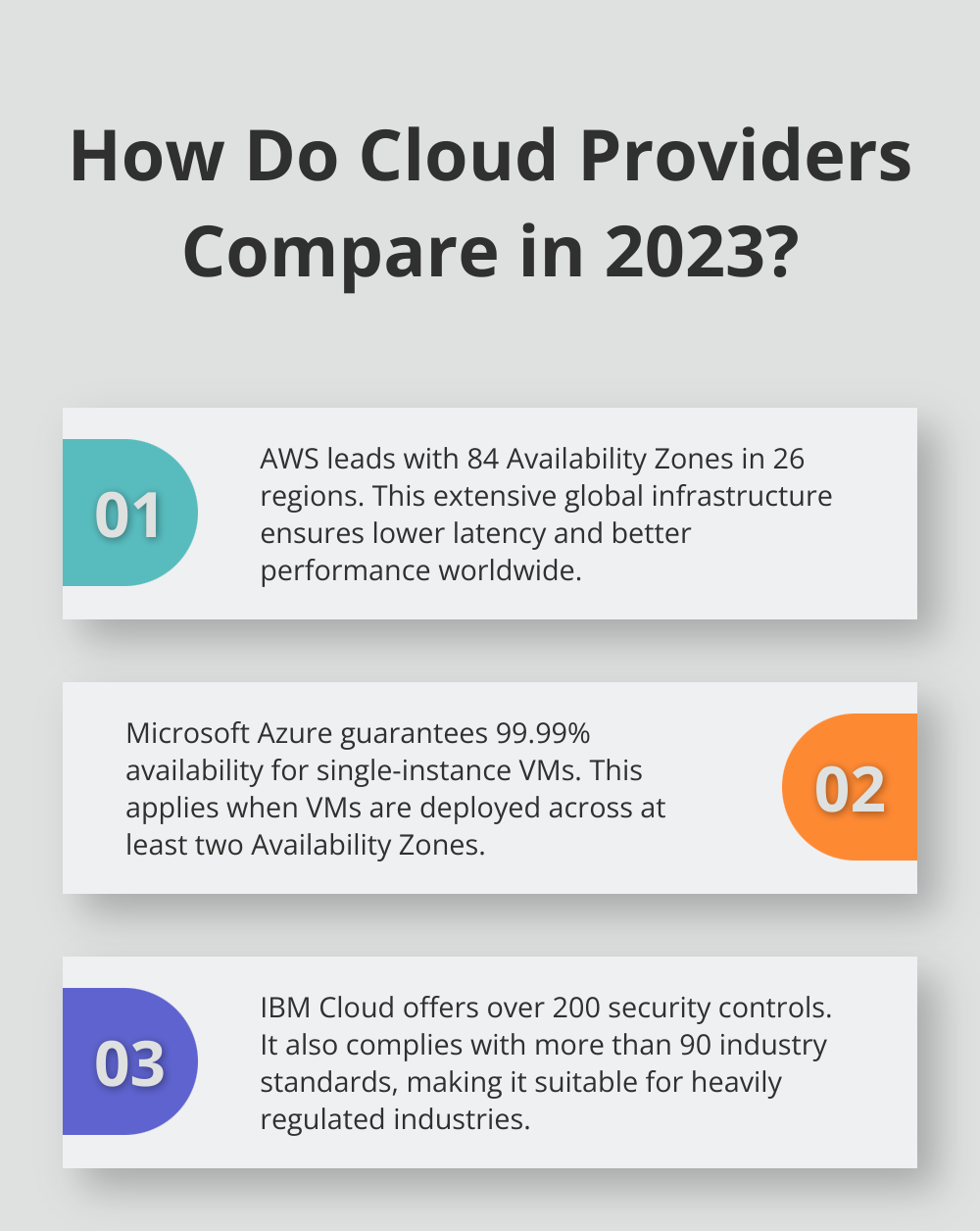The cloud service provider you choose can be a game-changer—or a source of friction. At UCaaS Review, we understand how this decision shapes everything from daily operations to long-term scalability.
In this post, we’ll compare the top cloud service providers and help you navigate the key factors to consider when making your choice. We’ll also explore how different providers cater to various use cases, ensuring you find the perfect fit for your unique needs.
Who Are the Major Cloud Service Providers?
Amazon Web Services (AWS): The Market Leader
Amazon Web Services (AWS) dominates the cloud computing landscape. The cloud market reached $330 billion in 2024, up $60 billion from 2023. AWS offers a comprehensive suite of services, including computing power, storage options, and machine learning tools. Its scalability and flexibility appeal to businesses of all sizes. However, AWS’s pricing structure can prove complex, potentially resulting in unexpected costs for less experienced users.
Microsoft Azure: The Hybrid Cloud Champion
Microsoft Azure has grown its market share, establishing itself as a formidable AWS competitor. Azure’s integration with Microsoft’s enterprise software gives it a significant edge in the corporate world. Its hybrid capabilities facilitate seamless mobility and consistent public and private cloud deployments. Azure’s AI and ML tools are widely used in enterprise automation and analytics pipelines. However, its interface and ecosystem can feel overwhelming for teams without prior experience in Microsoft-based environments.
Google Cloud Platform (GCP): The Data Analytics Powerhouse
Despite holding a smaller market share, GCP has established itself as a leader in data analytics and machine learning. Google’s expertise in these areas translates into powerful tools for businesses looking to harness big data. One of GCP’s key advantages is its simplified pricing structure. With per-second billing and fewer add-on fees, many teams find it easier to estimate monthly costs without surprises. For businesses watching their cloud spend closely—or just getting started—this level of predictability is a clear benefit. Still, GCP’s network is smaller than AWS and Azure’s, which may impact performance in regions where it lacks local infrastructure.
IBM Cloud: Hybrid Solutions Specialist
IBM Cloud focuses on hybrid cloud environments and AI integration, making it a solid choice for enterprises with complex infrastructure requirements. It focuses on enterprise-grade use cases such as mainframe modernization, regulated industry compliance, and AI-powered customer experience—areas where off-the-shelf platforms often fall short.
Oracle Cloud: Database Management Expert
Oracle Cloud excels in database management and business-critical applications. Like IBM Cloud, it offers strong security features and compliance tools. Oracle’s cloud services cater to organizations that require high-performance database solutions and seamless integration with existing Oracle products.

The choice of a cloud service provider significantly impacts operational efficiency and the bottom line. Each provider offers unique strengths and specializations. To make an informed decision, businesses must carefully evaluate their current and future needs against the offerings of these major players. The next section will explore the key factors to consider when choosing a cloud provider, helping you navigate this complex landscape.
What Factors Matter Most When Choosing a Cloud Provider?
Cost Considerations and Management
Pricing structures among cloud providers vary widely, making it essential to understand the total cost of ownership. AWS offers a pay-as-you-go model, but its complex pricing can lead to unexpected expenses. The 12th annual Flexera 2023 State of the Cloud Report revealed insights about cloud spend and resource allocation.

To stay in control of costs, prioritize providers that offer built-in budgeting dashboards, cost alerts, and granular billing breakdowns. These tools can prevent surprise overages and make it easier to justify infrastructure spending.
Performance Metrics and Reliability
A slowdown in cloud performance affects everything from customer response times to internal operations. That’s why guaranteed uptime and latency benchmarks should be non-negotiable when comparing providers.
Consider the geographic distribution of data centers as well. A provider with a global network of data centers can ensure lower latency and better performance for your users worldwide. AWS currently leads with the most extensive global infrastructure, boasting 84 Availability Zones within 26 geographic regions as of 2023.
Security Measures and Compliance Standards
A provider’s security tools—and how well they align with your compliance obligations—can make or break a cloud deployment. Look for built-in encryption, access control, and third-party audit certifications that match your industry’s needs.
IBM Cloud stands out with its strong focus on security, offering over 200 security controls and compliance with more than 90 industry standards. This makes it an excellent choice for industries with strict regulatory requirements (such as healthcare or finance).
When evaluating providers, ask about their compliance certifications. Does the provider adhere to standards relevant to your industry, such as HIPAA for healthcare or PCI DSS for e-commerce? A provider’s ability to meet these standards can save you significant time and resources in achieving and maintaining compliance.
Even with strong security tools in place, responsibility doesn’t disappear—it just gets divided.
Available Services and Features
Choose a provider whose tools align with your roadmap—whether that includes AI, containerized applications, or real-time collaboration. Breadth is good, but relevance matters more.
Some businesses find that a general cloud provider alone doesn’t meet all their communication needs, especially when seamless collaboration and integrated tools are essential. That’s where more specialized platforms come in. PanTerra Networks, for example, offers a unified communications platform that combines voice, messaging, video, file sync, and analytics—all in one secure environment. It’s a reminder that evaluating a provider’s services isn’t just about quantity, but how well those services fit your workflow.
Consider your specific needs. Do you require advanced AI and machine learning capabilities? GCP and Azure might be better choices. Need strong database management? Oracle Cloud excels in this area. Try to match the provider’s strengths with your business requirements.
Scalability and Flexibility
Growth rarely happens in a straight line, so it’s important to choose a provider that supports both rapid scaling and unexpected pivots. Look at how easily you can adjust compute capacity, add regions, or migrate services when needed.
Also, consider the ease of migrating data and applications. Some providers offer better tools and support for migration, which can significantly reduce the time and cost of moving to the cloud.
As we move forward, let’s explore how different cloud providers cater to various use cases, helping you further narrow down your options based on your specific requirements.
Which Cloud Provider Fits Your Business Case?
Small Businesses and Startups
For early-stage companies with lean tech teams, simplicity and budget transparency are critical. Platforms like DigitalOcean and GCP appeal here by offering intuitive dashboards and generous free-tier resources.

Google Cloud Platform (GCP) also caters well to smaller organizations. Its generous free tier provides ample resources for application building and testing without initial costs. GCP’s transparent pricing model helps small businesses predict and control their cloud expenses more effectively.
Enterprise-Level Organizations
Large enterprises require robust, scalable solutions with advanced features. Amazon Web Services (AWS) dominates this space, offering the most comprehensive service suite. Its vast global infrastructure ensures high availability and low latency worldwide. (Amazon continued to lead the worldwide IaaS market with revenue of $48.1 billion and 40% market share in 2022, according to Gartner.)
Microsoft Azure closely follows AWS for enterprise-level organizations, particularly those invested in the Microsoft ecosystem. Azure’s seamless integration with tools like Office 365 and Active Directory appeals to large businesses aiming for IT infrastructure consistency.
Data Analytics and Machine Learning
Google Cloud Platform leads in data analytics and machine learning. GCP’s BigQuery processes petabytes of data rapidly, while its AI and ML tools (built on Google’s own AI infrastructure) offer cutting-edge capabilities for businesses leveraging advanced analytics.
AWS competes strongly with services like Amazon SageMaker for machine learning. However, users often praise GCP’s tools for their ease of use and integration with popular data science frameworks.
Internet of Things (IoT) Applications
Microsoft Azure stands out for IoT applications with its Azure IoT Suite. This comprehensive platform offers tools for device management, data ingestion, and real-time analytics. Azure’s strong edge computing capabilities (essential for IoT deployments) give it an advantage in this domain.
AWS IoT provides another robust option, offering various services for connecting and managing IoT devices at scale. Its integration with other AWS services creates a seamless experience for businesses building comprehensive IoT solutions.
Hybrid and Multi-Cloud Strategies
As businesses adopt hybrid and multi-cloud strategies, providers supporting these approaches gain an edge. IBM Cloud excels here, focusing on hybrid cloud solutions.
Google’s Anthos platform stands out for multi-cloud strategies. It allows businesses to manage workloads across different cloud providers and on-premises infrastructure from a single interface, providing flexibility and avoiding vendor lock-in.
Bringing It All Together: Infrastructure Meets Communication
While choosing a cloud infrastructure provider sets the foundation for performance and scalability, it’s equally important to consider how your communication tools integrate into that environment. As operations become more distributed and teams rely on real-time collaboration, having unified communications that work seamlessly across cloud systems is critical.
This is where platforms with an all-in-one environment add value— combining voice, messaging, video, and file sharing—can simplify tech stacks and reduce the friction of managing multiple vendors. For teams aiming to streamline communication without sacrificing security or scalability, platforms designed with both cloud agility and end-user experience in mind are worth a closer look.
Final Thoughts
A strong cloud provider should do more than store your data—it should help your team move faster, troubleshoot less, and spend more time building. Each of the providers in this comparison brings distinct strengths to the table, which is why it’s crucial to align your choice with your operational priorities, not just brand recognition or buzzwords.

Security isn’t an afterthought anymore—it’s at the heart of every digital decision. The range of services and features offered by a provider can significantly impact your ability to innovate and scale. You should consider your current needs and future growth plans when assessing the available services.
At UCaaS Review, we understand the complexity of choosing the right cloud service provider. We have developed a platform that uses AI technology to match businesses with the best UCaaS providers in just minutes. Two businesses scale the same way—but with the right tools in place, the road ahead gets a lot smoother. At UCaaS Review, we aim to make that road easier to navigate.



